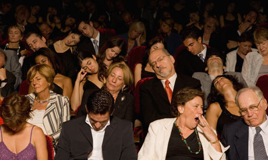Did your last presentation leave listeners feeling like snoozing after taking an Ambien or feeling ramped up like they’d just finished a Red Bull?
Did you know that only 3% of presentations are considered “stimulating” according to a survey taken by 200 vice presidents of large companies? In that same survey those VP’s ranked 44% of presentations as “boring” and 40% as “sleepy.” Does this surprise you, or are you looking forward to the next presentation as a place to catch a nap?
No doubt the goal of your presentation is not to ramp the audience up on Red Bull, but you can certainly stay away from the Ambien-like state produced by many presentations.
So how would you rank your last presentation? Where did you rank on the “stimulating to sleepy” scale?
Now go ask those who sat through your last presentation to rank you. No, really…go ask them. It’s a simple idea to get feedback in order to become a better presenter; however, we rarely, if ever, ask our audience for their opinion. If you don’t, you should.
Unless you are presenting at an insomniac convention, your goal isn’t to lull your audience to sleep, right? So why is there an expectation that most presentations are going to be either boring or sleepy? Well, because most presentations are either boring, sleepy, or both. Very few stimulate the audience.
Sometimes we use PowerPoint or Prezi presentations as a crutch, thinking the actual presentation is the focus. Maybe we think we as the presenter are the focus of the presentation. Which one is it…the presentation or the presenter? Here is the shocker: neither one should be the focus! The audience should be the focus of the presentation. Makes sense, doesn’t it?
The good news is that just a few changes in our thinking and planning can make a dramatic difference in whether our audience is stimulated, or sleepy and bored. Here are a few ideas to put you on a path to delivering presentations that stimulate your audience:
- Get stimulated about your information! Excitement is contagious and is much easier to pass along than trying to manufacture enthusiasm the day of your presentation. Be excited about your information itself, or the way the information will change the future, or what the information can tell us about beating the competition, etc. If you cannot get excited about presenting your information, don’t expect to stimulate your audience.
- Find the connection between the audience and your information. Recently, I attended a presentation of data from an employee survey. Boring, right? Not this time. The presenter made light of the mundane nature of data in a way that got the audience laughing and ultimately engaged in the survey results. It was fun, and he linked the data to changes to be made as a result of the employees’ feedback. He found the connection between the audience and the information.
- Plan your appearance and actions to stimulate the audience. This idea sounds out of place, however, according to a 10-year study titled “The Elements of Personal Communication” by Dr. Albert Mehrabian, a UCLA professor:
- Perfect practice! That’s right, perfect practice, and don’t think that reviewing your information the night before counts as perfect practice. Perfect practice means delivering your presentation out loud the same way you will deliver the actual presentation, perfectly. Don’t cut corners here. Practice perfectly until it is done the way you want. That means when you make a mistake go back and deliver it again without the mistake, perfectly. One great way to do this is to roll the video camera while practicing. Initially, you will be amazed. And unfortunately, I do not mean “amazed” in a good way. You probably do things non-verbally and verbally that you do not realize. I was surprised myself when I reviewed the video of my practice sessions. I was doing things unconsciously that were very distracting to my presentation. But practicing on camera helped me eliminate and add some things to stimulate the audience. Have fun with this one and review the video with the goal of learning, growing and changing to become a better presenter. Also, find a qualified person to review the video with you…someone who will be brutally honest.
The visual part of a presentation (your appearance, facial expressions and body language) accounts for 55% of the communication with the audience.
The vocal part of your presentation (your voice, pitch, tone and emphasis) accounts for 38% of the communication with the audience.
The verbal part of your presentation (the actual words you speak) accounts for 7% of the communication with the audience. Clearly, it is not what you present, but much more how you present your information.
Remember: Ambien or Red Bull?
What other ideas have helped you give better presentations? I would love to hear your thoughts, suggestions and stories!









